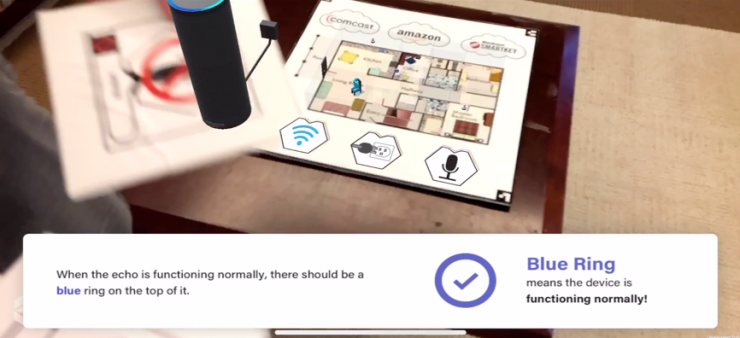Technology for Connected and Independent Living
Nov 12, 2019 — Atlanta, GA

Internet of Things (IoT) devices like smart thermostats, lightbulbs, and door locks show promising potential to support independent living for people aging with mobility disabilities. But there are challenges in selecting, installing, configuring, and using these devices.
Georgia Tech researchers are using augmented reality (AR) tools to help older adults with disabilities to choose smart home technology for their individual needs that will work in their homes.
The project is now in its second year. During the first year, researchers wanted to know what older adults with disabilities knew about smart home tech – Do they use it? If not, why? Study participants provided feedback about which products they're most interested in and tried out the voice-activated Amazon Echo, a device that’s easier to use for someone with a mobility impairment.
Researchers found, “There’s a lot of misunderstanding or incorrect expectations around what the devices do or how they work,” said Maribeth Gandy Coleman, the project’s principal investigator and director of Georgia Tech’s Interactive Media Technology Center.
Some study participants were hesitant to use the products because they felt overwhelmed or assumed that they wouldn’t be able to use them.
Currently, Coleman, along with Research Scientist Laura Levy and Research Technician Ben Thompson, are taking what they learned in the first year and have built a prototype that uses AR as a guided home tour. Study participants, with assistance, use a smartphone and AR-tracking product information cards to test different smart home technologies. Is the wi-fi strong enough in a particular corner of their home? Can they reach the device? Is the electrical outlet close enough?
“By situating virtual information for the person in the real world, we can help them better figure out what smart home tech would be best for them and their environment. It would help them be able to preview what the user experience would be like in their home,” Coleman explained.
There’s also an interactive, printed floor plan. “You’re able to see a bird’s eye view of the whole house.”
Potential consumers can develop she calls “a more robust mental model” of how smart home tech works, which could help them choose what to buy, where to install it, and how to fix any technical problems.
During the study, Coleman and her team discovered accessibility barriers with commercial augmented reality products. Microsoft’s HoloLens interface was difficult to use for people with certain mobility impairments because it involves pointing and pinching motions. Participants also had difficulty putting on and taking off the AR headset.
In addition to supporting consumers in finding the right smart home tech, Gandy said the AR experience could also help technology designers to create more accessible AR and VR products for older people as well as those with cognitive and physical disabilities, which impacts how they use these products at home and work.
"This could be critical if future job training is done through virtual reality," she said. "You could inadvertently be excluding someone from a job, not because they couldn't do the job but because the training was inaccessible. Better technology doesn't necessarily mean more accessible; it can mean less accessible."
This project is supported by TechSAge, a Rehabilitation Engineering Research Center (RERC) to support aging-in-place for people with long-term disabilities. The center is a collaboration between Georgia Tech and the University of Illinois at Urbana-Champaign. A grant from the National Institute on Disability, Independent Living, and Rehabilitation Research (NIDILRR) funds the center.
Alyson Powell Key
Marketing Communications Manager
Institute for People and Technology




